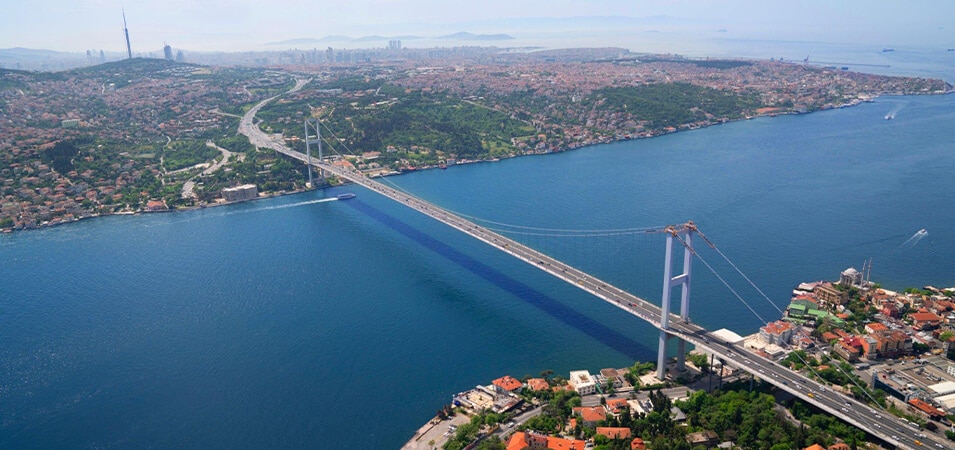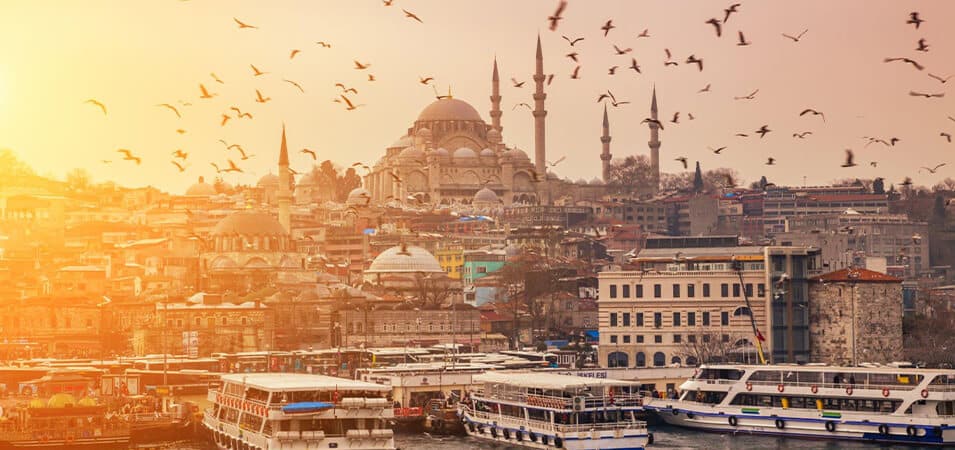The Bosporus Strait is a well-known and vital body of water that links Europe and Asia. It is an essential link between the Black Sea and the Mediterranean Sea. It is in the busy city of Istanbul, Turkey. The Bosporus Strait has been critical to the growth of societies and the sharing of ideas, things, and cultures because of its rich history and location.
The Bosporus has been a critical route for many countries and cultures. It has seen the Greek, Roman, Byzantine, and Ottoman societies come and go, leaving behind a mix of cultural elements. Throughout history, the strait has been a trade center, allowing things to move between Europe and Asia. It has also helped economic and political ties grow.
Geographical Overview of Bosporus Strait

Location and Boundaries
The Bosporus Strait is in Istanbul, Turkey. It is a natural border between Asia and Europe. It goes from the Sea of Marmara in the south to the Black Sea in the north. The gap is part of the border between Thrace, the European side of Istanbul, and Anatolia, the Asian side. Its position it has been an important river for hundreds of years, connecting the continents and making trade and cultural exchange easier.
How the Black Sea and the Sea of Marmara are linked
The Bosporus Strait connects the Black Sea and the Sea of Marmara significantly. The strait opens into the Istanbul Strait at its northern end, near the Black Sea. As ships head south, they pass through the Throat, the Bosporus’s narrowest and most prominent part. Beautiful hills and places of historical interest and homes surround this part. The strait finally opens into the Sea of Marmara, leading to the Mediterranean Sea.
How long, comprehensive, and deep is it
- The Bosporus Strait goes from the Black Sea to the Sea of Marmara and is about 30 kilometers (19 miles) long. Its width changes in different parts, with the Throat being the widest at about 3.7 kilometers (2.3 miles). At its broadest, the strait is about 700 meters (2,300 feet) wide near the Rumeli Hisar castle.
- The average depth of the Bosporus is between 50 and 120 meters (165 and 390 feet). In some places, though, it can go as deep as 124 meters (407 feet). The gap is deep and wide enough to let big ships through, making it an important trade route.
Things that make the Bosporus area special
- The area around the Bosporus is known for its stunning natural beauty and historical importance. From the hills on either side of the strait, you can see a comprehensive view of Istanbul and its most famous buildings, like the Hagia Sophia and the Topkapi Palace. On the Bosporus’s shores, many beautiful homes called yalis have different building styles from other times.
- The area around the Bosporus is also home to several ancient sites, such as the Rumeli Hisar Castle and the Dolmabahce Palace. These places show the importance of the strait as an important location throughout history and draw people worldwide.
- The Bosporus area is extraordinary and beautiful because it has a unique mix of physical traits, cultural history, and beautiful scenery. It continues to fascinate locals and tourists, making it clear that it is one of the world’s most critical and unique rivers.
Don’t Miss checking out our Turkey Tour Packages.
Bosporus Strait: Historical Significance
Role in Ancient Civilizations
- In the past of many old societies, the Bosporus Strait has been critical. The ancient Greeks, especially the city-state of Athens, knew how significant the gap was as a trade and settlement route to the Black Sea. They set up villages on the coasts of the Black Sea and used the Bosporus as a critical sea path.
- During the time of the Roman Empire, the Bosporus became a vital trade path that linked the rich resources of the Black Sea area to the Mediterranean world. The Roman Empire depended on the strait to get things like grain, wood, and metals to other parts of the empire. Since there were Romans in the area, important buildings like the Bridge of Constantine across the Bosporus were built.
- As the Byzantine Empire grew more robust, the Bosporus Strait became even more critical. Constantinople, now called Istanbul, was the capital of the Byzantine Empire. It was built on both sides of the strait, which was brilliant. The Bosporus was under Byzantine rule, which gave them a solid place to defend against attacks. The city became a hub for business and society, linking Europe and Asia.
Strategic Significance
- The Bosporus Strait has always been critical from a military point of view. Because of where it was, it was possible to control the movement of ships, which gave it power in trade, military activities, and diplomatic relations. The gap was like a natural wall that kept invaders and siegers from getting to Constantinople. It also allowed the Byzantine Empire to control and tax trade that went through the area, which helped the empire’s economy grow.
- Even after the fall of the Byzantine Empire, the Bosporus was still important from a military point of view. In 1453, Sultan Mehmed, the Conqueror, and the Ottoman Empire took over Constantinople and changed it into Istanbul. The Ottoman Empire knew how vital the strait was and set up the Istanbul Strait Commission to control navigation and ensure ships could pass safely.
- Recently, the Bosporus Strait has stayed the most important place for trade and movement between countries. It is a crucial route for oil trucks, cargo ships, and military ships going from the Black Sea to the Mediterranean Sea.

Environmental Aspects of Bosporus Strait
Impact of Increased Maritime Traffic
The increased number of ships in the Bosporus Strait has caused significant environmental problems. People are worried about river pollution, biodiversity loss, and oil spills because there are many business ships, tanks, and tourist ships. Ships pollute the air with their fumes, and when they dump bilge water and other waste, it can hurt the health of the water and the coastal species that live in it.
Efforts to keep the balance of nature
- Several attempts and measures have been taken to keep the natural balance of the Bosporus Strait. The Turkish government has implemented rules with foreign groups to reduce marine travel’s environmental damage. To keep ships safe and reduce the chance of crashes, these rules limit the size and speed of vessels and make pilotage services necessary.
- Also, environmental tracking systems have been set up to check the quality of the water, keep track of the amount of pollution, and find places of worry. These tracking attempts help find the sources of pollution and come up with ways to lessen their effects. Also, ships that pass through the strait are checked regularly to ensure they follow environmental rules.
The Strait has unique sea life
- The Bosporus Strait is necessary for the environment because it is home to many kinds of sea life. Many fish, like anchovies, bluefish, and mackerel, use the strait to move from one place to another. The strait has a healthy environment because it has a lot of air and a lot of food.
- The Mediterranean monk seal (Monachus), which is in danger of going extinct, is one of the most fascinating marine animals in the Bosporus. The strait is essential for these seals because it gives them places to breed and eat. Several things are being done to protect this endangered species, such as setting up protected areas and protection programs.
- Also, the Bosporus is known for its many kinds of birds. Many bird species, such as seagulls, herons, and cormorants, use the strait as an essential route for migration. During their long travels, these birds must eat and rest in the coastal areas and marshes near the bay.
Bosporus Strait: Economic Importance
- The Bosporus Strait is vital to the economy because it is a crucial passageway for foreign trade and ships. Its site is significant because it links the area around the Black Sea to the area around the Mediterranean Sea. This makes it easier for things to move between Europe, Asia, and the Middle East.
- The gap is essential for ships to get to and from big towns on both sides. On the European side, the Port of Istanbul and the Ambarl Port are major business hubs that handle a wide range of traffic, such as containers, large goods, and fuel products. On the Asian side, the Port of Haydarpaşa and the Port of Pendik are two of the most important places for trade and the economy.
- The Bosporus Strait makes moving things quickly and cheaply easy, saving time and money on long-distance shipping paths. It gives countries in the area access to markets and resources, which helps their economies grow and progress. The strait is essential for more than just the local economy because it links to global trade networks. This helps boost international trade and makes it easier for goods to move between countries.
- In addition, the area around the Bosporus is a busy business place. Istanbul draws businesses, investors, and tourists as a bridge between Europe and Asia. This boosts economic activity, creates jobs, and brings in money. The Bosporus area’s economic value is increased because it is home to major manufacturing, transportation, and tourism businesses.
Tourism and Recreation of Bosporus Strait
- Visitors worldwide come to the Bosporus area because it has many places to see and things to do. The site is famous because it has a lot of history, culture, and beautiful scenery.
- The Hagia Sophia, Topkapi Palace, and Blue Mosque in Istanbul are all popular places to visit in the Bosporus area. These historical places have beautiful buildings and tell stories about the area’s past. Also worth seeing are the Dolmabahce Palace and the Rumeli Hisar Castle, which have stunning views of the Bosporus Strait.
- Tourists love cruising along the Bosporus because they can see the beautiful shores, castles, and old homes called yalis. Many boat tours and trips let people know the strait and enjoy the beautiful scenery.
- People who like water sports can do many things on the Bosporus, such as rowing, fishing, and jet skiing. The strait’s calm seas and beautiful scenery make it an excellent place for these activities. There are also chances to go fishing and sail a boat, so there is something for everyone.
- Aside from the strait, the Bosporus area has a lively food scene, busy markets, and a vibrant nightlife that will make tourist trips memorable. The unique beauty of the Bosporus Strait and the mix of traditional and modern sights make it a great place to visit for fun, adventure, and cultural experiences.
conclusion
The Bosporus Strait is an important river that links Asia and Europe. Its importance in history and geography cannot be overstated. The strait was essential to the growth of old cultures like the Greeks, Romans, and Byzantines because it was an important trade and cultural exchange path.
The Bosporus Strait connects the Black Sea and the Sea of Marmara because of its unique location and borders. It is about 30 kilometers long, at its widest point, 3.7 kilometers wide, and in some places, it is as deep as 124 meters. The area around the bay is known for its beautiful scenery, historical sites, and wide range of sea life.
Don’t Miss to Check out our Related Article :
